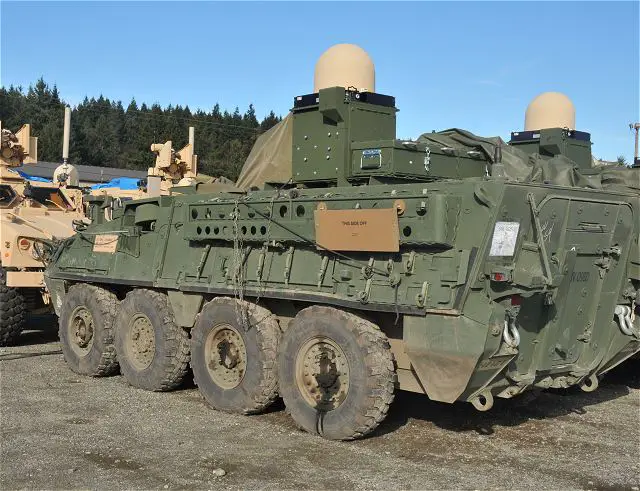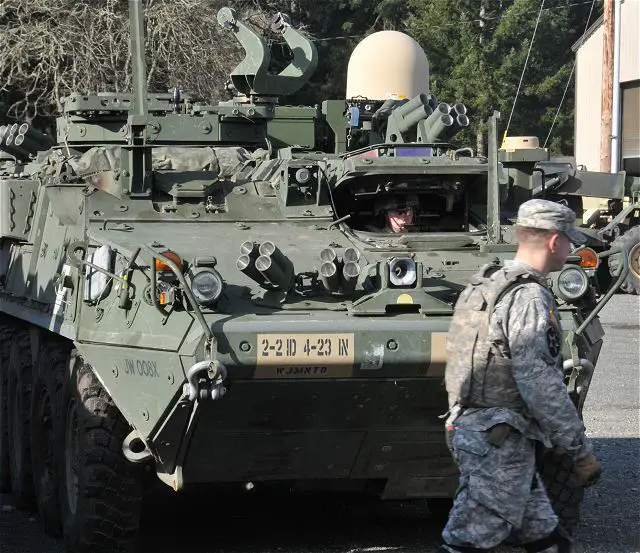Stryker 8x8 armoured of U.S. Army retrofitted with new tactical communication network system
|
Defense Industry Technology - US Stryker with Network system |
|||
|
|
|||
|
|
|||
| Stryker 8x8 armoured of U.S. Army retrofitted with new tactical communication network system. | |||
|
Stryker 8x8 armoured vehicles in the 2nd Stryker Brigade Combat Team/2nd Infantry Division of U.S. Army, also known as 2/2 SBCT, are being retrofitted with the Army's new tactical communications network, increasing Soldiers' ability to communicate over greater distances, share mission data and maintain situational awareness. By Nancy JonesBonbrest, PEO C3T
|
|||
|
|
|||
 Strykers in the 2nd Stryker Brigade Combat Team/2nd Infantry Division, or 2/2 SBCT, are being retrofitted with the Army's new tactical communications network, increasing Soldiers' ability to communicate over greater distances, share mission data and maintain situational awareness. Strykers in the 2nd Stryker Brigade Combat Team/2nd Infantry Division, or 2/2 SBCT, are being retrofitted with the Army's new tactical communications network, increasing Soldiers' ability to communicate over greater distances, share mission data and maintain situational awareness. |
|||
|
|
|||
|
The new mobile communications system, known as Capability Set 15, or CS 15, provides improved connectivity throughout the SBCT, reducing the units' reliance on fixed and line-of-sight communications. "These capabilities give commanders a huge advantage in knowing what is happening on the battlefield," said Capt. Minou Pak, signal company commander for the 2/2 SBCT, based at Joint Base Lewis-McChord, Washington. "It is a much more redundant system, which we can use to react quicker and maneuver through the battlefield much faster and more efficiently." Select Strykers are being equipped with the satellite-based network communications capabilities of Warfighter Network Information-Tactical, also known as WIN-T, Increment 2, Blue Force Tracking, also known as BFT 2, Joint Capabilities Release, also known as JCR, software and other upgraded mission command systems. WIN-T Increment 2, fielded at brigade, battalion and company echelons, enables deployed Soldiers operating in remote and challenging terrain to maintain voice, video and data communications while on patrol, with connectivity rivaling what's typically found in a stationary command post. JCR/BFT 2 enables advanced command and control down to the platoon and squad, including situational awareness, friendly force tracking and mission command capabilities. "CS 15 provides a capability for leaders at all levels to be able to talk throughout the battlefield," said Maj. Tom Piazze, brigade engineer with the 2/2 SBCT. "If you can talk more effectively throughout the battlefield, it makes everyone's job that much easier. It gives the commanders the ability to push orders down and makes them aware of where their Soldiers are and what the battlefield looks like." Through that information, Soldiers can make proactive decisions allowing them to find their enemy fast and act first. "It gives Soldiers an advantage because it is a much faster way to communicate," said Sgt. Ellis Choi, a squad leader with the 2/2 SBCT. "The Soldier can keep live chats, live situational awareness and collaborate. All this information will give commanders faster communications and a better view of the battlefield. This definitely gives the Army a second generation of technology." The Army's SBCTs fill a critical role in terms of deployability, mobility, protection, speed and lethality that bridges the gap between the capabilities of armored BCT and infantry BCT formations. The 2/2 SBCT is the third SBCT to be fielded with capability set technologies. The Army will continue to field additional SBCTs network capability. |
|||
|
|
|||
 |
|||
|
|
|||
|
Before delivering the new network systems to the Stryker units, the capabilities were validated through the Network Integration Evaluations, or NIEs, a series of events that leverage the 2nd Brigade, 1st Armored Division, conducting rigorous mission scenarios in a realistic operational environment at Fort Bliss, Texas, and White Sands Missile Range, New Mexico
Feedback from Soldiers at the NIEs and those assigned to capability set-fielded BCTs is helping to shape communications equipment and technology for future units. The Army is continuing to work on simplifying its tactical communications systems so they are easier for Soldiers to operate and require minimal training or intervention by civilian field support representatives. As the Army shifts from developing system-specific, stove-piped tactical communications capabilities to delivering a network that is integrated across the BCT formation, training is also shifting to focus on a system of systems approach. Drawing on lessons learned from previous units fielded with the integrated communications package, the training includes instruction on how the systems function as a group in various mission scenarios. This training will continue to evolve as the Army incorporates additional Soldier input. Maj. Jeff Brizek, the S6 or communications officer for the 2/2 SBCT, said identifying the right Soldiers for training was crucial. "We tried to lean forward and tell units to be sure the Soldiers they send were going to [be] here for a while and that they were going to be the ones using this equipment," Brizek said. "We made this training our number one priority." Across infantry and Stryker formations, the Army has fielded a total of 12 BCTs and four division headquarters with capability sets. The service will continue to field capability sets to select BCTs in accordance with operational needs, while also executing upgrades to other non-CS units to improve capacity and ensure interoperability across the force. Brizek said the new self-forming, self-healing capabilities are critical since they remove the need to have a vehicle or Soldier tethered to a spot to ensure line-of-sight communications. "We can fight now with untethered capabilities, that's the power of this fielding," Brizek said. "It separates everyone from their command posts. So now, in the vehicle, they have the capability to use digital communications and we didn't have that before." |
|||
|
|


























